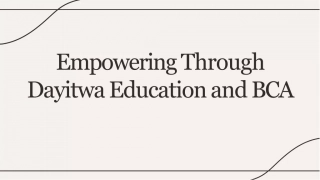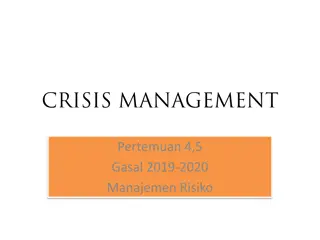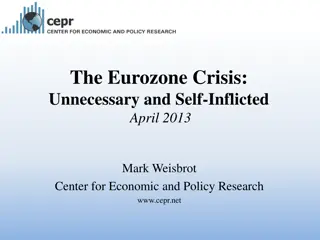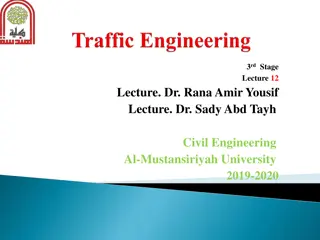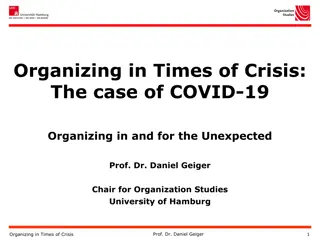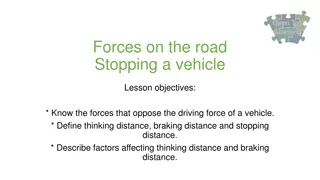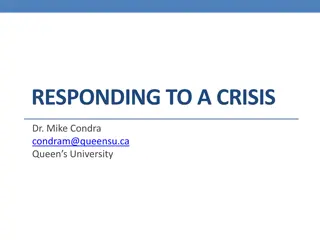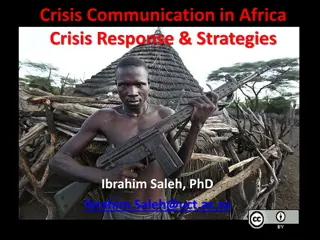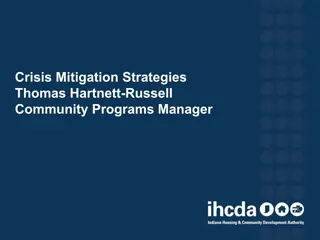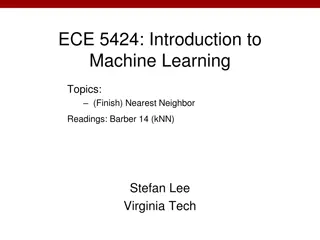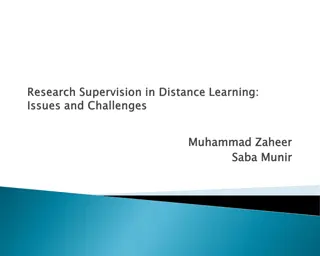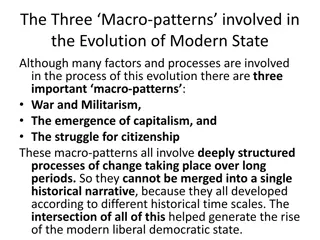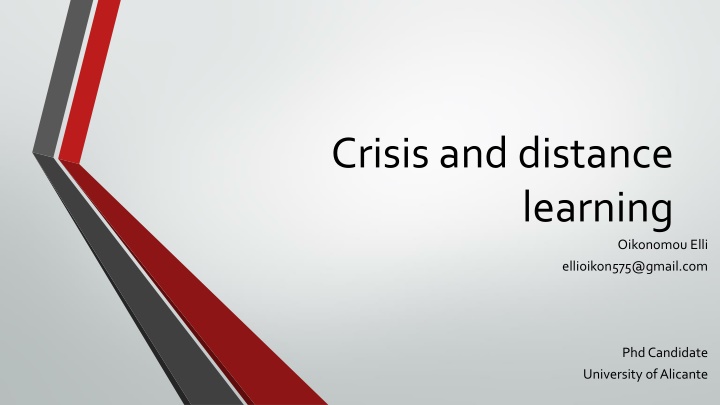
Crisis in Education: Challenges of Distance Learning
The COVID-19 pandemic has disrupted education worldwide, leading to a rapid shift towards distance learning. This transition has posed significant challenges for students, educators, and policymakers, highlighting existing inequalities in access to quality education. Addressing these issues requires collaborative efforts to ensure equal opportunities for all learners, regardless of their circumstances.
Download Presentation

Please find below an Image/Link to download the presentation.
The content on the website is provided AS IS for your information and personal use only. It may not be sold, licensed, or shared on other websites without obtaining consent from the author. If you encounter any issues during the download, it is possible that the publisher has removed the file from their server.
You are allowed to download the files provided on this website for personal or commercial use, subject to the condition that they are used lawfully. All files are the property of their respective owners.
The content on the website is provided AS IS for your information and personal use only. It may not be sold, licensed, or shared on other websites without obtaining consent from the author.
E N D
Presentation Transcript
Crisis and distance learning Oikonomou Elli ellioikon575@gmail.com PhdCandidate University of Alicante
The COVID-19 pandemic has led to a global crisis in education, with schools and universities closing their doors to prevent the spread of the virus. As a result, distance learning has become the new norm for students of all ages.
This sudden shift to online education has presented numerous challenges for both students and educators. Many students lack access to reliable internet and technology, making it difficult for them to participate in virtual classes. Additionally, the lack of face-to-face interaction with teachers and peers can lead to feelings of isolation and disengagement.
Educators have also had to adapt quickly to the new reality of distance learning, learning how to effectively deliver lessons and engage students through online platforms. This has required a significant amount of time and effort, and many teachers have struggled to maintain the same level of quality in their instruction.
Furthermore, the crisis has highlighted existing inequalities in education, with students from low-income families and marginalized communities facing even greater barriers to accessing distance learning.
As the crisis continues, it is essential for policymakers, educators, and technology companies to work together to address these challenges and ensure that all students have equal access to quality education, regardless of their circumstances. This may involve providing devices and internet access to students in need, offering additional support for educators, and developing innovative approaches to online learning.
Policymakers play a crucial role in addressing the challenges of distance learning during the crisis. They can allocate resources to provide devices and internet access to students in need, as well as support educators in developing effective online teaching methods. Additionally, policymakers can work to bridge the digital divide by investing in infrastructure and technology that will ensure equal access to quality education for all students.
Educators also have a significant responsibility in adapting to distance learning. They can collaborate with policymakers and technology companies to develop innovative approaches to online education, create engaging and interactive virtual lessons, and provide additional support to students who may be struggling with the transition to remote learning.
Technology companies can contribute by providing educational platforms and tools that are accessible, user-friendly, and tailored to the needs of both students and educators. They can also offer technical support and resources to ensure that all students have the necessary technology and connectivity to participate in distance learning.
By working together, policymakers, educators, and technology companies can address the challenges of distance learning during the crisis and ensure that all students have equal access to quality education, regardless of their circumstances. This collaborative effort is essential in mitigating the impact of the crisis on education and creating a more equitable learning environment for all.
Benefits of distance learning: Flexibility: Students can study at their own pace and at a time that is convenient for them. Accessibility: Distance learning allows students to access education from anywhere in the world, as long as they have an internet connection. Cost-effective: Distance learning can be more affordable than traditional in-person education, as it eliminates the need for commuting and other associated costs. Personalized learning: Students can tailor their learning experience to their own needs and preferences, and can access a wide range of resources and materials. Work-life balance: Distance learning allows students to balance their education with work and other commitments, making it easier to pursue further education while maintaining a career.
Weaknesses of distance learning: Lack of face-to-face interaction: Distance learning can be isolating, as it lacks the in-person interaction and social aspects of traditional education. Technology issues: Technical problems and internet connectivity issues can disrupt the learning experience and hinder students' ability to access course materials and participate in online classes. Self-discipline: Distance learning requires a high level of self-motivation and discipline, as students must manage their own time and stay on track with their studies without the structure of a traditional classroom setting. Limited practical experience: Some courses may require hands-on practical experience, which can be difficult to replicate in a distance learning environment. Quality of education: The quality of distance learning programs can vary, and some students may feel that they receive a lower quality education compared to traditional in-person programs.
References: Borokhovski, E., Bernard, R., Mills, E., Abrami, P. C., Wade, C. A., Tamim, R., & Surkes, M. A. (2011). An extended systematic review of Canadian policy documents on e-Learning: What we re doing and not doing. Canadian Journal of Learning and Technology/La revue canadienne de l apprentissage et de la technologies, 37(3). Gonz lez Herrero, A., & Pratt, C. B. (1996). An integrated symmetrical model for crisis-communications management. Journal of Public Relations Research, 8(2), 79-105. Coombs, W. T., & Holladay, S. J. (2005). An Exploratory Study of Stakeholder Emotions: Affect and Crises. The Effect of Affect in Organizational Settings, 263 280.

